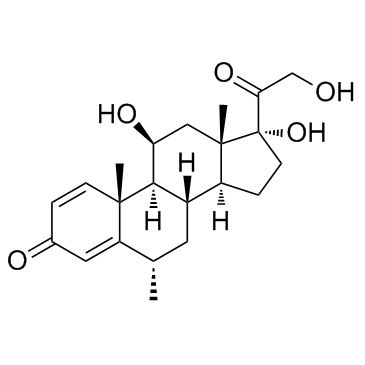83-43-2
| Name | 6α-methylprednisolone |
|---|---|
| Synonyms |
(6S,8S,9S,10R,11S,13S,14S,17R)-11,17-dihydroxy-17-(2-hydroxyacetyl)-6,10,13-trimethyl-7,8,9,11,12,14,15,16-octahydro-6H-cyclopenta[a]phenanthren-3-one
MFCD00010591 EINECS 201-476-4 Methylprednisolone 6alpha-methylprednisolone |
| Description | Methylprednisolone is a synthetic corticosteroid with anti-inflammatory and immunomodulating properties.Target: Glucocorticoid ReceptorMethylprednisolone is typically used for its anti-inflammatory effects. Common uses include arthritis therapy and short-term treatment of bronchial inflammation or acute bronchitis due to various respiratory diseases. Methylprednisolone is used both in the treatment of acute periods and long-term management of autoimmune diseases, most notably systemic lupus erythematosus. It is also used for vestibular neuritis [1].After six months the patients who were treated with methylprednisolone within eight hours of their injury had significant improvement as compared with those given placebo in motor function (neurologic change scores of 16.0 and 11.2, respectively; P = 0.03) and sensation to pinprick (change scores of 11.4 and 6.6; P = 0.02) and touch (change scores, 8.9 and 4.3; P = 0.03). Benefit from methylprednisolone was seen in patients whose injuries were initially evaluated as neurologically complete, as well as in those believed to have incomplete lesions [2]. |
|---|---|
| Related Catalog | |
| References |
| Density | 1.3±0.1 g/cm3 |
|---|---|
| Boiling Point | 571.8±50.0 °C at 760 mmHg |
| Melting Point | 228-237°C (dec.) |
| Molecular Formula | C22H30O5 |
| Molecular Weight | 374.471 |
| Flash Point | 313.7±26.6 °C |
| Exact Mass | 374.209320 |
| PSA | 94.83000 |
| LogP | 1.99 |
| Vapour Pressure | 0.0±3.6 mmHg at 25°C |
| Index of Refraction | 1.603 |
| Storage condition | 0-6°C |
| Water Solubility | chloroform/methanol (9:1): 50 mg/mL, clear, faintly yellow |
Synonym:Medro Section 2 - COMPOSITION, INFORMATION ON INGREDIENTS
Risk Phrases: 40 Section 3 - HAZARDS IDENTIFICATION EMERGENCY OVERVIEW
Limited evidence of a carcinogenic effect. Potential Health Effects Eye: May cause eye irritation. Skin: Harmful if absorbed through the skin. Ingestion: Harmful if swallowed. Inhalation: Harmful if inhaled. May cause irritation of the respiratory tract with burning pain in the nose and throat, coughing, wheezing, shortness of breath and pulmonary edema. Chronic: Not available. Section 4 - FIRST AID MEASURES Eyes: Flush eyes with plenty of water for at least 15 minutes, occasionally lifting the upper and lower eyelids. Get medical aid. Skin: Get medical aid. Flush skin with plenty of water for at least 15 minutes while removing contaminated clothing and shoes. Ingestion: Get medical aid. Wash mouth out with water. Inhalation: Remove from exposure and move to fresh air immediately. If not breathing, give artificial respiration. If breathing is difficult, give oxygen. Get medical aid. Notes to Physician: Section 5 - FIRE FIGHTING MEASURES General Information: As in any fire, wear a self-contained breathing apparatus in pressure-demand, MSHA/NIOSH (approved or equivalent), and full protective gear. Extinguishing Media: Use foam, dry chemical, or carbon dioxide. Section 6 - ACCIDENTAL RELEASE MEASURES General Information: Use proper personal protective equipment as indicated in Section 8. Spills/Leaks: Vacuum or sweep up material and place into a suitable disposal container. Section 7 - HANDLING and STORAGE Handling: Avoid breathing dust, vapor, mist, or gas. Avoid contact with skin and eyes. Storage: Store in a cool, dry place. Store in a tightly closed container. Section 8 - EXPOSURE CONTROLS, PERSONAL PROTECTION Engineering Controls: Use adequate ventilation to keep airborne concentrations low. Exposure Limits CAS# 83-43-2: Personal Protective Equipment Eyes: Not available. Skin: Wear appropriate protective gloves to prevent skin exposure. Clothing: Wear appropriate protective clothing to prevent skin exposure. Respirators: Follow the OSHA respirator regulations found in 29 CFR 1910.134 or European Standard EN 149. Use a NIOSH/MSHA or European Standard EN 149 approved respirator if exposure limits are exceeded or if irritation or other symptoms are experienced. Section 9 - PHYSICAL AND CHEMICAL PROPERTIES Physical State: Powder Color: white Odor: Not available. pH: Not available. Vapor Pressure: Not available. Viscosity: Not available. Boiling Point: Not available. Freezing/Melting Point: 227-231 deg C Autoignition Temperature: Not available. Flash Point: Not available. Explosion Limits, lower: Not available. Explosion Limits, upper: Not available. Decomposition Temperature: Solubility in water: Insoluble. Specific Gravity/Density: Molecular Formula: C22H30O5 Molecular Weight: 374.207 Section 10 - STABILITY AND REACTIVITY Chemical Stability: Stable. Conditions to Avoid: Incompatible materials. Incompatibilities with Other Materials: Strong oxidizing agents, acids, acid chlorides, carbon dioxide, acid anhydrides. Hazardous Decomposition Products: Nitrogen oxides, carbon monoxide, carbon dioxide. Hazardous Polymerization: Will not occur. Section 11 - TOXICOLOGICAL INFORMATION RTECS#: CAS# 83-43-2: TU4146000 LD50/LC50: CAS# 83-43-2: Oral, rat: LD50 = >4 gm/kg. Carcinogenicity: 6-alpha-Methylprednisolone - Not listed by ACGIH, IARC, or NTP. Other: See actual entry in RTECS for complete information. Section 12 - ECOLOGICAL INFORMATION Section 13 - DISPOSAL CONSIDERATIONS Dispose of in a manner consistent with federal, state, and local regulations. Section 14 - TRANSPORT INFORMATION IATA No information available. IMO No information available. RID/ADR No information available. Section 15 - REGULATORY INFORMATION European/International Regulations European Labeling in Accordance with EC Directives Hazard Symbols: XN Risk Phrases: R 40 Limited evidence of a carcinogenic effect. Safety Phrases: S 36/37 Wear suitable protective clothing and gloves. S 45 In case of accident or if you feel unwell, seek medical advice immediately (show the label where possible). WGK (Water Danger/Protection) CAS# 83-43-2: No information available. Canada CAS# 83-43-2 is listed on Canada's NDSL List. CAS# 83-43-2 is not listed on Canada's Ingredient Disclosure List. US FEDERAL TSCA CAS# 83-43-2 is listed on the TSCA inventory. SECTION 16 - ADDITIONAL INFORMATION N/A |
CHEMICAL IDENTIFICATION
HEALTH HAZARD DATAACUTE TOXICITY DATA
|
| Personal Protective Equipment | Eyeshields;Gloves;type N95 (US);type P1 (EN143) respirator filter |
|---|---|
| Hazard Codes | Xi |
| Risk Phrases | R36/37/38 |
| Safety Phrases | S22-S36 |
| RIDADR | NONH for all modes of transport |
| WGK Germany | 2 |
| RTECS | TU4146000 |
